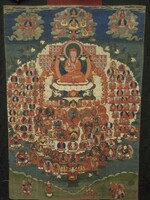The Earliest Sakya Refuge Field Painting

This image is of the earliest known Sakya Refuge Field painting - Field of Accumulation - to appear in any museum or private collection (or known mural in situ). It is dated by style to the 20th century. The depiction follows the traditional Sakya textual descriptions for placing the lineage of teachers on a flat plane surrounding the central Vajradhara or Guru figure - in this case it is Sakya Pandita. This Sakya configuration differs from others such as Jamgon Kongtrul's description of placing the lineage teachers one above the other in a vertical line. This however doesn't mean that the various traditions only have one way of doing things. What has become clear is that how things are presented in the liturgical texts describing visualizations is not necessarily how the artists depict those very specific descriptions.
Very recently, paintings depicting Sakya Refuge Fields have been created (see HAR #61218, #89994) but in the style described by Jamgon Kongtrul using the Karma Kagyu 'five branch' tree model and a vertical hierarchy (see example). In 1979/80 a very detailed drawing of a Sakya Refuge Field was created that followed very closely the compsoition and style of the Gelug Tradition based on the writings of the 1st Panchen Lama. Is this possibly an instance where art and the popularity of a particular Refuge Field composition & style is dictating the iconography even where there is no traditional textual basis?
Because of this relatively new tradition of creating Refuge Field paintings a fascinating window has opened that allows an insight into the relationship between art & iconography, religious texts, the actual living practices, practitioners themselves and how they create and use visual forms.
Sakya Refuge Field Page - updated
